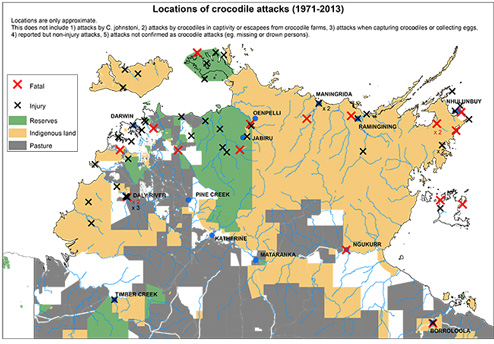Body Recovered by Rescue Teams after Saltwater Crocodile Attack
Crocodile Victim – Police Recover Body
A spokesperson for the police services in the Northern Territory (Australia) has confirmed that the body of a man snatched by a Saltwater crocodile has been recovered. The victim, named as 26 year-old Sean Cole, was attacked by a large four-metre-plus crocodile as he and a friend attempted to swim across the Mary River during a birthday party. Despite numerous signs indicating the danger of crocodile attacks and warnings from locals, it seems that Sean chose to go for a swim in a river renowned for having one of the highest densities of large crocodiles in the whole of Australia.
Saltwater Crocodile Attack
Sean was celebrating a friends 30th birthday and he another male party goer decided to swim the river, Sean was attacked as he swam back having reached the opposite bank. Onlookers watched in horror as Sean was suddenly attacked. The attack took place on Saturday afternoon, the body was recovered today just a few yards from where the attack took place. In a statement, the police claim that the body was recovered around 5.30am this morning (local time).
Senior Sergeant Geoff Bahnert stated:
“Several of the group in the party witnessed the male being taken in the jaws of the croc for a period of time, and then he was out of sight. The Mary River is known worldwide to have the greatest saturation of adult Saltwater crocodiles in the world. You don’t swim in the Mary River.”
At least four crocodiles have been shot in the area following the incident, rangers say, including one believed to be responsible for Mr Cole’s attack. The Mary River Wilderness Retreat, just seventy miles south-east of Darwin is a popular destination for tourists and locals seeking a break from the city. As there are a number of large crocodiles known to be in the vicinity there are plenty of warning signs alerting visitors to the potential danger of a crocodile attack.
A Fatal Incident
This latest fatal incident comes at a time when the Northern Territory Department of Land Resource Management has released figures that show that there have been eighteen fatal Saltwater crocodile attacks since the legal protection of the species came into force in 1971.
Contrary to popular belief, it is not tourists who seem to be the most at risk from crocodile attacks. Wildlife scientist Yusuke Fukuda, who compiled the report, said sixteen of those fatalities were Territorians (local residents). The data is based on sixty-two confirmed attacks, fourteen of the victims were male. The department’s figures do not include attacks by crocodiles in captivity or when capturing crocodiles or collecting their eggs. The figures also do not include attacks with no reported injuries or unconfirmed attacks such as suspected drownings or missing persons. The data excludes any attacks from the smaller Freshwater crocodile (C. johnstoni).
Map Showing Location of Crocodile Attacks 1971 to 2013
Picture credit: Northern Territory Department of Land Resource Management
A Growing Crocodile Population
Reflecting on how the local crocodile population has recovered since hunting was banned, Charlie Manolis, chief scientist at Crocodylus Park, a tourist attraction and crocodile research station in the Northern Territory, commented that during the days of hunting from the 1940s to the end of the 1960s, the Mary River region was one of the best spots to find large crocodiles. By the time the hunting ban came into force in 1971, there were very few crocodiles left in the river system. He went onto add that large crocodiles were regularly seen in the Mary River these days, the vast majority have moved into the river system from other parts of the Northern Territory.
He stated:
“Slowly the population has increased. In a lot of the areas, the Mary River is quite different from other rivers. There is very little breeding that goes on, a lot of those animals that live there came from somewhere else. They are a bit like ‘boat crocs’ I suppose. That is why there are so many, there are a lot of large crocodile males, so the population is biased towards the males. As the population has increased over the last ten years, so more of the reptiles are moving into the upper freshwater areas.”
When asked to consider the action of the birthday party guests who tried to swim across the river, the chief scientist added:
“When you try and swim across a river that has ten crocs or one, there is still a chance you are going to get attacked.”
Dr Manolis stated that culling opened the chance for people to get a false sense of confidence of going into the water and urged caution before considering a cull as a method of managing the crocodile population. He also said the consumption of alcohol was a factor in about half the crocodile deaths nationwide.


